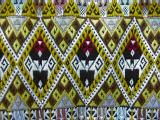 THAILAND--Part Six
THAILAND--Part Six
 At
the same time that Sukhothai was a great power, the kingdom of Lan Na Thai
to the north was also becoming very important. The capital of Lan Na was
the city of Chiang Mai, which didn't actually become a part of Thailand
itself until only about one hundred years ago. Today, Chiang Mai is the
largest city in northern Thailand and the second largest in all of Thailand.
Some of the remains of the distant past are visible today: the walls surrounding
the old city are still standing (in some places rebuilt, but in others crumbling
or completely destroyed), and the moat (on the left in this photo) is still
there, too.
At
the same time that Sukhothai was a great power, the kingdom of Lan Na Thai
to the north was also becoming very important. The capital of Lan Na was
the city of Chiang Mai, which didn't actually become a part of Thailand
itself until only about one hundred years ago. Today, Chiang Mai is the
largest city in northern Thailand and the second largest in all of Thailand.
Some of the remains of the distant past are visible today: the walls surrounding
the old city are still standing (in some places rebuilt, but in others crumbling
or completely destroyed), and the moat (on the left in this photo) is still
there, too.
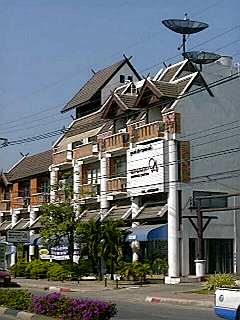 Chiang
Mai's most obvious characteristic is the juxtaposition (combination) of
that old world with the new and the modern. As soon as you get out of the
old city, you encounter brand-new buildings like this one. But not everything
about this building is new. See those X-shaped figures at the peak of the
roof? That figure is called a kalae (pronounced "gah-lay), and it's
a common architectural feature in this area that goes back hundreds of years.
Chiang
Mai's most obvious characteristic is the juxtaposition (combination) of
that old world with the new and the modern. As soon as you get out of the
old city, you encounter brand-new buildings like this one. But not everything
about this building is new. See those X-shaped figures at the peak of the
roof? That figure is called a kalae (pronounced "gah-lay), and it's
a common architectural feature in this area that goes back hundreds of years.
 You
can see a kalae more easily here. Thailand may not have been colonized,
and Thai people are very proud of their independence, but they sure like
things Western...
You
can see a kalae more easily here. Thailand may not have been colonized,
and Thai people are very proud of their independence, but they sure like
things Western...
 ...so
it's really easy to find a lot of familiar things to make you feel at home.
While a lot of this kind of development IS taking place, the Thai feel that
Chiang Mai may be building up a little TOO fast; so, there are laws limiting
the amount of development in and right around the city. I hope it's successful,
because Chiang Mai right now is a very pleasant and interesting city without
being TOO big. It's kind of like the San Francisco of Thailand, the way
Bangkok is like LA: it's in the north, it's cooler, it's smaller and less
frantic, and it's a cultural center in a beautiful environment. (Not that
LA and Bangkok aren't cultural centers, too!) It also gets more tourists,
like SF, and a lot of foreigners even choose to live here. (There's another
city even farther north called Chiang Rai that I think of as Thailand's
Seattle: pretty far from everything but really pretty and the kind of place
"insiders" know about that isn't quite as popular a place to visit -- YET.)
...so
it's really easy to find a lot of familiar things to make you feel at home.
While a lot of this kind of development IS taking place, the Thai feel that
Chiang Mai may be building up a little TOO fast; so, there are laws limiting
the amount of development in and right around the city. I hope it's successful,
because Chiang Mai right now is a very pleasant and interesting city without
being TOO big. It's kind of like the San Francisco of Thailand, the way
Bangkok is like LA: it's in the north, it's cooler, it's smaller and less
frantic, and it's a cultural center in a beautiful environment. (Not that
LA and Bangkok aren't cultural centers, too!) It also gets more tourists,
like SF, and a lot of foreigners even choose to live here. (There's another
city even farther north called Chiang Rai that I think of as Thailand's
Seattle: pretty far from everything but really pretty and the kind of place
"insiders" know about that isn't quite as popular a place to visit -- YET.)
 Look
familiar? Malls like these are all over the big cities of Thailand, though
they're most evident in Bangkok. This is Central, the only big mall in Chiang
Mai, and as you'd imagine it's a major hangout place for young people. Check
out the Baskin-Robbins, Burger King and Mister Donut in the background for
more signs of Western influence. It would be hard to call Burger King or
McDonald's here fast food, though -- the Thai food stands are MUCH faster!
Look
familiar? Malls like these are all over the big cities of Thailand, though
they're most evident in Bangkok. This is Central, the only big mall in Chiang
Mai, and as you'd imagine it's a major hangout place for young people. Check
out the Baskin-Robbins, Burger King and Mister Donut in the background for
more signs of Western influence. It would be hard to call Burger King or
McDonald's here fast food, though -- the Thai food stands are MUCH faster!
 Look
carefully at this sign from the mall directory. It's interesting to see
which stores are listed in English and which are in Thai. There's a good
deal of English spoken in Chiang Mai because of the tourism industry, which
brings English-speaking people to the area and, therefore, the need for
local people to be able to speak to them (so that they'll buy things, which
creates jobs, mostly). Still, there's a constant
debate about how much to allow Western influences to affect Thai culture.
Look
carefully at this sign from the mall directory. It's interesting to see
which stores are listed in English and which are in Thai. There's a good
deal of English spoken in Chiang Mai because of the tourism industry, which
brings English-speaking people to the area and, therefore, the need for
local people to be able to speak to them (so that they'll buy things, which
creates jobs, mostly). Still, there's a constant
debate about how much to allow Western influences to affect Thai culture.
 There
are also movie theaters in Central Mall, some of which show English-language
features with Thai subtitles. Everyone in the theater stands before the
main feature, when the king's picture is screened and the national anthem
is played. Then comes the movie -- and even some great ones, like this!
There
are also movie theaters in Central Mall, some of which show English-language
features with Thai subtitles. Everyone in the theater stands before the
main feature, when the king's picture is screened and the national anthem
is played. Then comes the movie -- and even some great ones, like this!
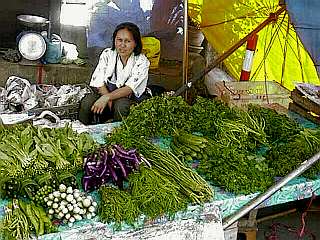 I
said before that it's impossible to describe how much food you find along
the streets of Thailand. Well, it's equally impossible to describe the density
of the markets. EVERYTHING is sold here, from vegetables of incredible variety...
I
said before that it's impossible to describe how much food you find along
the streets of Thailand. Well, it's equally impossible to describe the density
of the markets. EVERYTHING is sold here, from vegetables of incredible variety...
 ...to
all different kinds of meats, some of which you're likely to have eaten
and others, probably not.
...to
all different kinds of meats, some of which you're likely to have eaten
and others, probably not.
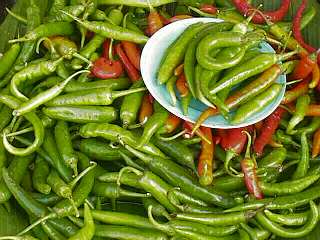 A
lot of Thai food, especially in the south but in the north as well, is very
hot and spicy because of the use of chili peppers like these. A traditional
northern Thai dish is papaya salad, which is made VERY spicy with the use
of chilies.
A
lot of Thai food, especially in the south but in the north as well, is very
hot and spicy because of the use of chili peppers like these. A traditional
northern Thai dish is papaya salad, which is made VERY spicy with the use
of chilies.
 Dishes
in the north are different from those in the other parts of the country;
each area has its own "regional cuisine". Most of the differences are in
the spices used, though the north uses more noodles than the south and the
rice is different -- it's called "sticky rice", and is eaten with your hands
rather than utensils. You just grab a glob of rice, wrap it around one of
the main dishes, and shove it into your mouth -- no need to worry about
cleaning up until the end of the meal. As in most places in Thailand, though,
meals include a variety of meats and vegetables, often in soups and curries
but at other times fried or sautéed. You can find them in restaurants,
served in big trays (you just point at the dishes you want),...
Dishes
in the north are different from those in the other parts of the country;
each area has its own "regional cuisine". Most of the differences are in
the spices used, though the north uses more noodles than the south and the
rice is different -- it's called "sticky rice", and is eaten with your hands
rather than utensils. You just grab a glob of rice, wrap it around one of
the main dishes, and shove it into your mouth -- no need to worry about
cleaning up until the end of the meal. As in most places in Thailand, though,
meals include a variety of meats and vegetables, often in soups and curries
but at other times fried or sautéed. You can find them in restaurants,
served in big trays (you just point at the dishes you want),...
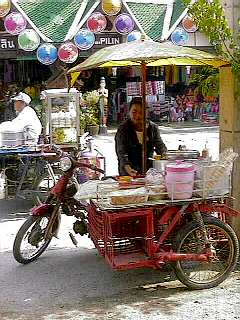 ...or
just wait for one of these "food cycles" to come by.
...or
just wait for one of these "food cycles" to come by.
 And,
like everywhere, fruit is a major part of the diet. It just happened while
I was here that durians came into season. I happen to think that
durian is the most absolutely disgusting fruit in the world (it has a REALLY
powerful smell, which to me is like something rotten, and a creamy texture
-- so that, as someone once told me, eating one is like "licking fine brie
cheese off a toilet seat -- YECCH!). But other people absolutely LOVE it!
(I've also heard that about ten people a year die from durian -- not from
eating it, but from sitting under durian trees and having the heavy, spiked
fruit fall off the tree and crack their heads open.) I was personally very
happy when I checked into a hotel and opened the information folder to see
an image of a durian with that international "no" symbol (the red circle
and slash) over it! I guess some other people can't stand the smell, either...
And,
like everywhere, fruit is a major part of the diet. It just happened while
I was here that durians came into season. I happen to think that
durian is the most absolutely disgusting fruit in the world (it has a REALLY
powerful smell, which to me is like something rotten, and a creamy texture
-- so that, as someone once told me, eating one is like "licking fine brie
cheese off a toilet seat -- YECCH!). But other people absolutely LOVE it!
(I've also heard that about ten people a year die from durian -- not from
eating it, but from sitting under durian trees and having the heavy, spiked
fruit fall off the tree and crack their heads open.) I was personally very
happy when I checked into a hotel and opened the information folder to see
an image of a durian with that international "no" symbol (the red circle
and slash) over it! I guess some other people can't stand the smell, either...
 Well,
I guess if some of you found that photo description disgusting, you'll find
this even more so. I finally decided I'd have to try some of these interesting
little delicacies. They were actually pretty good!
Well,
I guess if some of you found that photo description disgusting, you'll find
this even more so. I finally decided I'd have to try some of these interesting
little delicacies. They were actually pretty good!
 One
very northern Thai dish (pictured here with a drink of young coconut) is
khao soi. I love khao soi for two reasons -- not only does it taste
absolutely delicious, but it also has a great story behind it that tells
about the history of the region. The original form of this dish is the Yunnanese
noodles of southern China. Yunnanese Muslim traders brought the dish with
them as they moved through the region, and in each place they came to the
locals picked it up and added their own influences, based on their own tastes
and the locally-available ingredients. In Myanmar, for example, it became
a dish called kao suey, which I look forward to trying when I get
there. This kao suey eventually came with the traders into northern Thailand,
where the Thai gave it their own twist and turned it into khao soi (by adding
coconut milk, for example, among other changes). Most people would say that
khao soi is better than any of its previous "ancestors" -- another example
of how the Thai take the best of other cultures (again, in this case, Chinese)
and make it even better.
One
very northern Thai dish (pictured here with a drink of young coconut) is
khao soi. I love khao soi for two reasons -- not only does it taste
absolutely delicious, but it also has a great story behind it that tells
about the history of the region. The original form of this dish is the Yunnanese
noodles of southern China. Yunnanese Muslim traders brought the dish with
them as they moved through the region, and in each place they came to the
locals picked it up and added their own influences, based on their own tastes
and the locally-available ingredients. In Myanmar, for example, it became
a dish called kao suey, which I look forward to trying when I get
there. This kao suey eventually came with the traders into northern Thailand,
where the Thai gave it their own twist and turned it into khao soi (by adding
coconut milk, for example, among other changes). Most people would say that
khao soi is better than any of its previous "ancestors" -- another example
of how the Thai take the best of other cultures (again, in this case, Chinese)
and make it even better.
 Remember
how I pointed out that Thai temples are used for many things other than
religious purposes, including for sports? One day I was walking around and
caught sight of these boys playing sepak ("kick") takraw. Takraw
describes several games played with a woven wicker ball. One version is
like hacky-sack, with participants standing in a circle and using all parts
of the body except the hands to keep the ball in the air. Sepak takraw is
more like volleyball, only participants can't use their hands. It's amazing
to see the moves they make -- some even do backflips, spiking the ball over
the net in mid-air with their foot! Thailand usually vies with Malaysia
to be world champions in the sport, and won back the Asia Games gold medal
this year after coming in second for the past four years in a row to the
Malaysians. Other popular sports and games in Thailand: soccer (number ONE,
as in most of the world), badminton, muay thai style boxing (as you've
already seen), and kite fighting (which sounds REALLY cool, but I've never
gotten to see it).
Remember
how I pointed out that Thai temples are used for many things other than
religious purposes, including for sports? One day I was walking around and
caught sight of these boys playing sepak ("kick") takraw. Takraw
describes several games played with a woven wicker ball. One version is
like hacky-sack, with participants standing in a circle and using all parts
of the body except the hands to keep the ball in the air. Sepak takraw is
more like volleyball, only participants can't use their hands. It's amazing
to see the moves they make -- some even do backflips, spiking the ball over
the net in mid-air with their foot! Thailand usually vies with Malaysia
to be world champions in the sport, and won back the Asia Games gold medal
this year after coming in second for the past four years in a row to the
Malaysians. Other popular sports and games in Thailand: soccer (number ONE,
as in most of the world), badminton, muay thai style boxing (as you've
already seen), and kite fighting (which sounds REALLY cool, but I've never
gotten to see it).
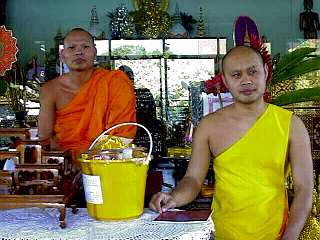 Farther
back in the temple, I got to meet two very outgoing monks who were happy
to talk to me about their lives in the monastery. One of the first things
you may have noticed in this photo is that they have shaved their heads
(one even shaved his eyebrows); I asked them the significance of this, and
they told me that it is because monks are supposed to focus on their meditation
and study, and not be concerned about "everyday" things like hairstyles.
That goes for their clothes, too. A monk's only personal possessions are
his yellow or orange robes and the bowl he uses to collect alms (food
donations) in the morning. I also asked how long they'd been monks. Each
had been ordained (blessed as monks) in their teens, and made the
decision to devote their lives to Buddhism when they turned twenty. Many
Thai men are ordained and become monks at least once in their lives, as
an opportunity to escape the rush of daily life, to study Buddhist teachings,
to meditate, and to have a purifying experience; however, most only stay
temporarily, spending an average of about three months at the monastery
before returning to their normal routines.
Farther
back in the temple, I got to meet two very outgoing monks who were happy
to talk to me about their lives in the monastery. One of the first things
you may have noticed in this photo is that they have shaved their heads
(one even shaved his eyebrows); I asked them the significance of this, and
they told me that it is because monks are supposed to focus on their meditation
and study, and not be concerned about "everyday" things like hairstyles.
That goes for their clothes, too. A monk's only personal possessions are
his yellow or orange robes and the bowl he uses to collect alms (food
donations) in the morning. I also asked how long they'd been monks. Each
had been ordained (blessed as monks) in their teens, and made the
decision to devote their lives to Buddhism when they turned twenty. Many
Thai men are ordained and become monks at least once in their lives, as
an opportunity to escape the rush of daily life, to study Buddhist teachings,
to meditate, and to have a purifying experience; however, most only stay
temporarily, spending an average of about three months at the monastery
before returning to their normal routines.
 Walking
back onto the streets, you can see that Buddhism is not the only
force that guides the lives of Thai people. Here, a small offering of leftover
food from breakfast has been left on the curb so that the spirits of the
street and the ancestors of those who work there will be fed and not disturb
the daily goings-on -- another piece of evidence of people's animist beliefs,
and perhaps of Chinese influence (in ancestor worship).
Walking
back onto the streets, you can see that Buddhism is not the only
force that guides the lives of Thai people. Here, a small offering of leftover
food from breakfast has been left on the curb so that the spirits of the
street and the ancestors of those who work there will be fed and not disturb
the daily goings-on -- another piece of evidence of people's animist beliefs,
and perhaps of Chinese influence (in ancestor worship).
 And,
in this Buddhist temple you can see how Hinduism can actually be merged
with Buddhism, so that people need not hold to only one or the other but
can take for themselves the best from both sets of beliefs. This sculpture
is of Ganesh, a the elephant-headed god from Hindu mythology. He's given
an equal position to the other figures, mostly Buddhist, who are honored
in the temple.
And,
in this Buddhist temple you can see how Hinduism can actually be merged
with Buddhism, so that people need not hold to only one or the other but
can take for themselves the best from both sets of beliefs. This sculpture
is of Ganesh, a the elephant-headed god from Hindu mythology. He's given
an equal position to the other figures, mostly Buddhist, who are honored
in the temple.
 But,
again, Buddhism is clearly the dominant religion in Thailand. This "Naga
Buddha" is at Wat Phra That Doi Suthep, the holiest temple around Chiang
Mai. Temple visitors have covered the figure in gold leaf, which they buy
at the temple; it costs ten baht (25 cents) for about a dozen super-thin,
two-inch by two-inch sheets of 100% gold leaf, and you even get two flowers,
six candles and several sticks of incense thrown in to make offerings with.
(You can also spend ten baht to buy about five or six baby birds in a wicker
cage that you crack open, letting them free.) The story of the naga is a
famous one. While Prince Siddharta Gautama, the to-be-Buddha, was meditating
under the bodhi tree in his quest for enlightenment, a fierce, torrential
rain began to fall, and the resultant flooding threatened to wash Siddharta
from his spot. The naga (multi-headed snake) saved the day by coiling himself
underneath the meditating prince, lifting him above the raging flood waters,
and even spread out his hooded heads above the prince to keep him dry.
But,
again, Buddhism is clearly the dominant religion in Thailand. This "Naga
Buddha" is at Wat Phra That Doi Suthep, the holiest temple around Chiang
Mai. Temple visitors have covered the figure in gold leaf, which they buy
at the temple; it costs ten baht (25 cents) for about a dozen super-thin,
two-inch by two-inch sheets of 100% gold leaf, and you even get two flowers,
six candles and several sticks of incense thrown in to make offerings with.
(You can also spend ten baht to buy about five or six baby birds in a wicker
cage that you crack open, letting them free.) The story of the naga is a
famous one. While Prince Siddharta Gautama, the to-be-Buddha, was meditating
under the bodhi tree in his quest for enlightenment, a fierce, torrential
rain began to fall, and the resultant flooding threatened to wash Siddharta
from his spot. The naga (multi-headed snake) saved the day by coiling himself
underneath the meditating prince, lifting him above the raging flood waters,
and even spread out his hooded heads above the prince to keep him dry.